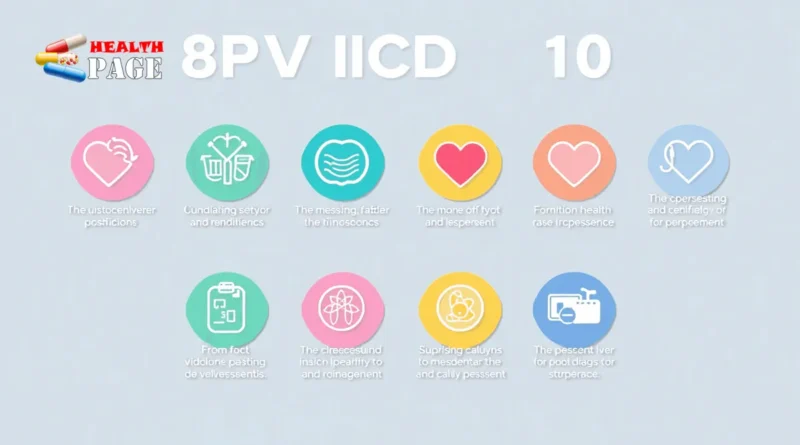7 Surprising Facts About BPV ICD 10 That Could Save Your Health
Have you ever experienced sudden dizziness that makes the world spin around you? You might be dealing with Benign Paroxysmal Vertigo (BPV), a condition caused by displaced crystals in your inner ear. These tiny “ear rocks” normally help you maintain balance, but when they break free, they can trigger unexpected episodes of vertigo.
The medical world tracks BPV through a specific classification system called ICD-10, where it’s identified as code H81.1. This code serves as a universal language for healthcare providers, ensuring accurate diagnosis and proper treatment paths for patients like you.
Why should you care about these medical codes?
- They determine how your condition is documented
- They influence your treatment protocol
- They affect insurance coverage and billing
- They impact the quality of care you receive
Understanding BPV ICD-10 coding isn’t just about medical paperwork – it’s about your health. The right code can lead to faster diagnosis, appropriate treatment, and better health outcomes. Whether you’re experiencing symptoms or supporting someone who is, knowing these coding nuances could make a significant difference in the journey toward recovery.
Let’s explore seven surprising facts about BPV ICD-10 that could transform your understanding of this condition and potentially save your health.
1. The Mysterious Link Between BPV and Ear Diseases in ICD-10 Coding
The medical code H81.1 represents Benign Paroxysmal Vertigo in the ICD-10 classification system. This specific code belongs to a broader category of ear-related conditions, highlighting the intricate connection between BPV and the ear’s anatomy.
Your inner ear houses a complex system of tubes filled with fluid and crystals. These crystals, when properly positioned, help maintain balance. In BPV cases, these crystals become dislodged, creating a chain reaction that affects your entire balance system.
The ICD-10 coding system places BPV under diseases of the ear and mastoid process for specific reasons:
- Anatomical Location: BPV originates in the inner ear’s vestibular system
- Symptom Manifestation: The condition directly affects ear-related functions
- Treatment Approach: Medical interventions target ear-specific issues
The mastoid process plays a crucial role in BPV cases. This honeycomb-like bone structure:
- Connects to your inner ear
- Houses important balance-related structures
- Influences treatment decisions when complications arise
ICD-10 coding recognizes several BPV variations:
- H81.10: BPV, unspecified ear
- H81.11: BPV of right ear
- H81.12: BPV of left ear
- H81.13: BPV of bilateral ears
Medical professionals use these specific codes to:
- Document the exact location of your condition
- Track treatment progress
- Communicate effectively with other healthcare providers
- Ensure proper insurance billing
The relationship between BPV and ear diseases extends beyond simple classification. Your ear’s intricate structure directly influences how BPV manifests, making accurate coding essential for proper diagnosis and treatment planning.
2. Understanding the Importance of ICD-10 Codes in Medical Documentation for BPV Patients
Accurate ICD-10 coding is crucial for documenting the medical history of BPV patients. The H81.1 code serves as a standardized identifier that facilitates communication among healthcare professionals, insurance companies, and medical institutions.
Key Elements of BPV Documentation
When documenting BPV cases, the following components are essential:
- Primary Diagnosis Code: H81.1 identifies the specific condition
- Laterality Indicators: Specifies which ear is affected
- Additional Symptom Codes: Documents associated conditions
- Treatment Response Codes: Records therapeutic interventions
For more on the importance of accurate coding in such documentation, refer to this resource.
The Role of ICD-10 Codes in the Billing Process
The H81.1 code plays a significant role in various billing procedures:
- Insurance coverage verification
- Treatment authorization
- Payment processing
- Medicare/Medicaid reimbursement rates
Healthcare facilities depend on accurate coding to support their financial operations, including justifying medical necessity, documenting treatment plans, supporting insurance claims, and tracking patient outcomes.
Requirements for Clinical Documentation
To support the H81.1 code and ensure successful insurance claims, your medical record must contain specific information:
- Detailed symptom description
- Physical examination findings
- Diagnostic test results
- Treatment protocols
- Follow-up care plans
Insurance companies carefully review these records to validate claims and determine coverage eligibility for required treatments and medications. This highlights the importance of insurance verification services, which ensure that the necessary documentation is accurate and comprehensive.

The Ongoing Impact of ICD-10 Coding
During each patient visit, healthcare providers update BPV codes to reflect any changes in the patient’s condition:
- Changes in severity
- New symptoms
- Treatment effectiveness
- Recovery progress
This continuous documentation process creates a comprehensive medical history that enables healthcare providers to deliver personalized care while also fulfilling regulatory obligations. Such meticulous documentation also plays a vital role in determining Medicare coverage and reimbursement rates for treatments provided.
3. Navigating the Fine Line Between Dizziness and BPV in ICD-10 Coding
Distinguishing between general dizziness and Benign Paroxysmal Vertigo requires careful attention to symptom presentation and diagnostic criteria. The R42 code specifically addresses dizziness and giddiness as standalone symptoms, while H81.1 targets BPV’s unique characteristics.
Key Differences Between R42 and H81.1 Codes:
- R42 (Dizziness and Giddiness)
- Used for non-specific dizziness symptoms
- Applied when the root cause remains unidentified
- Covers general sensations of lightheadedness
- Temporary coding solution during diagnostic processes
- H81.1 (Benign Paroxysmal Vertigo)
- Specific to vertigo caused by inner ear crystal displacement
- Requires confirmed diagnosis through testing
- Indicates recurring episodes of vertigo
- Links directly to vestibular system dysfunction
Medical professionals use specific diagnostic criteria to determine the appropriate code. The R42 code serves as a preliminary diagnosis when patients first report dizziness symptoms. Once testing confirms BPV through methods like the Dix-Hallpike maneuver, the coding shifts to H81.1.
Common R42 Symptoms vs BPV Indicators:
R42 Symptoms:
- General lightheadedness
- Unsteadiness
- Non-specific balance issues
- Various causes possible
BPV Indicators:
- Sudden onset vertigo
- Position-triggered symptoms
- Short duration episodes
- Clear pattern of occurrence
Healthcare providers must document specific symptom patterns to justify the transition from R42 to H81.1 coding. This distinction impacts treatment protocols and insurance coverage decisions. Accurate coding ensures patients receive appropriate care aligned with their specific condition rather than general symptom management.
The diagnostic journey from R42 to H81.1 often involves specialized testing and observation periods. Your healthcare provider might maintain both codes during initial visits until establishing a definitive diagnosis through comprehensive evaluation.
4. Understanding the Importance of Specific ICD-10 Codes for BPV Patients
ICD-10 codes for BPV include specific letters and numbers that provide important diagnostic information. These codes offer a comprehensive understanding of your condition through a structured classification system.
1. Diagnostic Certainty Letters
These letters indicate the level of certainty regarding your BPV diagnosis:
- Confirmed Diagnosis (D): Indicates a definitive BPV diagnosis based on clinical testing
- Provisional Diagnosis (P): Suggests BPV is suspected but requires additional confirmation
- Rule Out Diagnosis (R): Used when BPV needs to be excluded as a potential cause
- Working Diagnosis (W): Applied during ongoing evaluation of symptoms
2. Laterality Indicators in BPV Coding
The ICD-10 system uses specific digits to indicate which ear is affected by BPV:
- H81.11 – Right ear involvement
- H81.12 – Left ear involvement
- H81.13 – Bilateral involvement
- H81.19 – Unspecified ear
Your medical records might show combinations of these codes. For example, “H81.11D” indicates a confirmed diagnosis of BPV affecting your right ear, while “H81.12P” suggests a provisional diagnosis in your left ear.
3. Additional Code Modifiers
In addition to the above codes, there are modifiers that provide further details:
- Initial encounter: First time you’re seen for BPV
- Subsequent encounter: Follow-up visits
- Sequela: Long-term effects of BPV
These detailed coding variations help healthcare providers:
- Track the progression of your condition
- Plan appropriate treatment strategies
- Communicate effectively with other medical professionals
- Process insurance claims accurately
The specificity of these codes ensures you receive targeted care based on your exact diagnosis. Healthcare providers use this detailed coding system to document the precise nature of your BPV, leading to more personalized treatment approaches.
Seeking Professional Help: The Key to Accurate Diagnosis and Treatment for BPV Symptoms
Self-diagnosis through online ICD-10 code research can lead to misinterpretation and delayed proper treatment. Medical professionals possess specialized training to:
- Perform specific diagnostic tests
- Identify underlying causes
- Rule out serious conditions
- Create personalized treatment plans
Warning Signs That Require Professional Attention:
- Severe dizziness lasting more than a few minutes
- Recurring episodes of vertigo
- Hearing loss or tinnitus
- Balance problems affecting daily activities
- Nausea and vomiting during episodes
Healthcare providers use advanced diagnostic tools like the Dix-Hallpike test and electronystagmography to accurately diagnose BPV. These tests can’t be replicated at home and are crucial for proper diagnosis.
Risks of Self-Diagnosis:
- Missed serious underlying conditions
- Incorrect treatment methods
- Worsening symptoms
- Delayed professional care
- Potential complications
Your healthcare provider can perform the Epley maneuver, a specialized treatment technique that repositions the displaced crystals in your inner ear. This procedure has a success rate of 80% when performed by trained professionals.
Licensed medical practitioners also provide:
- Proper documentation for insurance claims
- Ongoing monitoring of symptoms
- Medication management when needed
- Prevention strategies
- Expert guidance for at-home exercises
Conclusion
Understanding the nuances of BPV ICD-10 coding is crucial for your healthcare journey. These seven surprising facts highlight the intricate relationship between proper medical coding and effective treatment outcomes.
Your health decisions deserve informed, professional guidance backed by accurate diagnostic codes. The complex connection between BPV symptoms, ear diseases, and medical documentation directly impacts the quality of your treatment.
Remember:
- Accurate coding leads to precise diagnoses
- Professional medical guidance remains irreplaceable
- Your treatment success depends on proper code documentation
With this knowledge about BPV ICD-10 codes, you’re better equipped to participate in your healthcare decisions while recognizing the importance of expert medical consultation for optimal treatment outcomes.
FAQs (Frequently Asked Questions)
What is BPV and how is it represented in ICD-10 coding?
Benign Paroxysmal Vertigo (BPV) is a condition related to inner ear crystals causing dizziness. In ICD-10 coding, BPV is classified under code H81.1, which falls under diseases of the ear. Understanding this code helps in accurate diagnosis and treatment.
Why is accurate ICD-10 coding important for BPV patients?
Accurate ICD-10 coding for BPV ensures proper communication of diagnosis among healthcare providers, supports correct billing processes, and ultimately improves patient care and treatment outcomes by reflecting the precise medical condition.
How do I differentiate between dizziness and BPV using ICD-10 codes?
Dizziness and giddiness are coded under R42 in ICD-10, whereas BPV specifically uses H81.1. It’s crucial to use H81.1 when diagnosing BPV to distinguish it from general dizziness for better clinical documentation and treatment.
What do diagnostic certainty letters in ICD-10 codes indicate for BPV cases?
Diagnostic certainty letters in ICD-10 codes provide information about the level of confidence in the diagnosis and specify whether the left or right ear is affected in BPV cases, aiding precise medical documentation and targeted treatment.
How does the mastoid process relate to BPV in ICD-10 coding?
The mastoid process is part of the temporal bone near the inner ear where BPV originates. Its significance in ICD-10 coding lies in its anatomical relation to diseases like BPV classified under ear disorders, helping clinicians localize the condition accurately.
Why should patients with suspected BPV seek professional healthcare advice instead of self-diagnosing based on ICD codes?
Seeking professional healthcare ensures accurate diagnosis and appropriate treatment as healthcare professionals interpret ICD codes within clinical context. Self-diagnosis based solely on ICD codes can lead to misdiagnosis and ineffective management of BPV symptoms.


